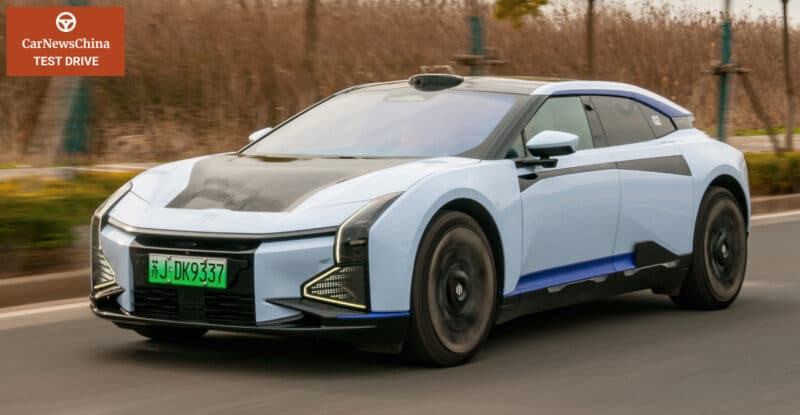Taking the HiPhi Z for a spin: China’s electrifying GT sets its sights on the Porsche Taycan
The HiPhi formula appears to be for CEO Ding Lei to ask his engineers and designers “what can you do for me?” and then say yes to all of it. And with the brand’s first car, the X, this seemed to be a winning formula. A unique seven door arrangement that combined both gullwing and suicide doors for the rear passengers, along with features like four wheel drive and steering the X was genre bending. Those with the RMB600k plus needed to buy the car loved it, making it regularly top the sales charts for premium EVs in China.

HiPhi, a brand from tech start-up Human Horizons, hopes that it can repeat the trick with its second car, the Z. Aimed as a twin halo car together with the X the new car although it shares the same platform and retails for a similar price is a very different beast. This time the Z is a much easier to categorize electric GT.

Exterior
When I first got to preview the HiPhi Z in early November 2021 my first reaction was ‘what the f**k’ but then on a second take I came around. HiPhi’s design philosophy is shock and awe at its finest. Avant-garde, the car is unlike anything on the road and is a real head-turner.


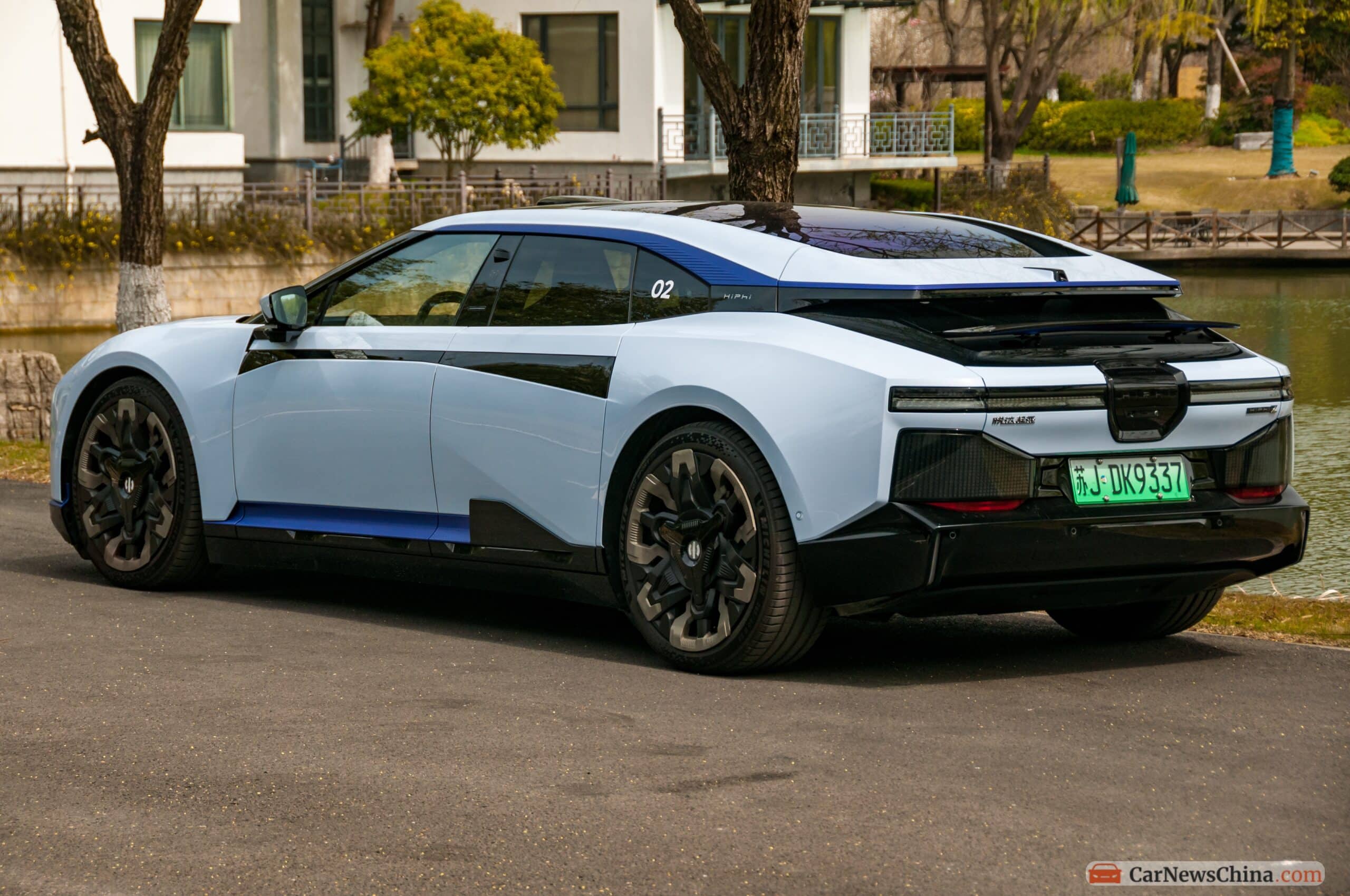
Despite its sleek looking lines, the car is actually massive with a length of 5036mm and a width of 2018mm. Surprisingly the Z is not particularly aerodynamic for a large EV with a drag coefficient of 0.27Cd. Originally the design called for wing cameras but current Chinese regulations don’t allow for this, meaning it gets traditional mirrors. It’s possible that export versions may gain this function which will help reduce drag and likely lead to a small boost in range and performance. As it is, there is no rear windshield meaning the HiPhi Z relies on a camera to provide an image for the rear view mirror.
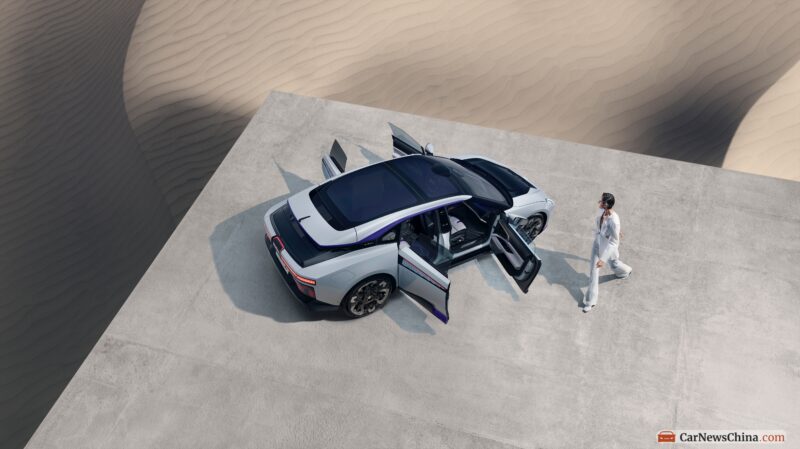
While the Z doesn’t get an opening roof like the X, it does get the suicide door portion of the setup.
Interior & Infotainment
Currently, there are just two versions of the HiPhi Z: a five-seater which goes for RMB 610 000 (USD 88 600) and a four-seater for RMB 630 000 (USD 91 500). Mounted on the B-pillar are a sensor for the key card along with buttons to open the doors. To close the driver’s door you press the brake pedal. Doors can also be closed via swiping the digital twin on the center mounted infotainment screen or by voice command.

Like the Tesla Model 3/Y, there is just one central screen, a 15-inch 2k AMOLED unit, which controls everything. Mounted by rods the HiPhi Bot as the system is known is actually in front of the dashboard. The rods allow the screen to rotate and it can even dance to some videos. On a more practical level, the screen can be moved towards the driver or passenger via voice command, the keypad on the steering wheel or by physically moving it.
A lot of thought has gone into the usability of the system with information about the car fixed at the top left, and on the bottom of the screen are some short cuts known as the Mini Bar for the AC temperature, airflow and also media volume. HiPhi claims that the vast majority of functions users need can be accessed through either one or two steps.

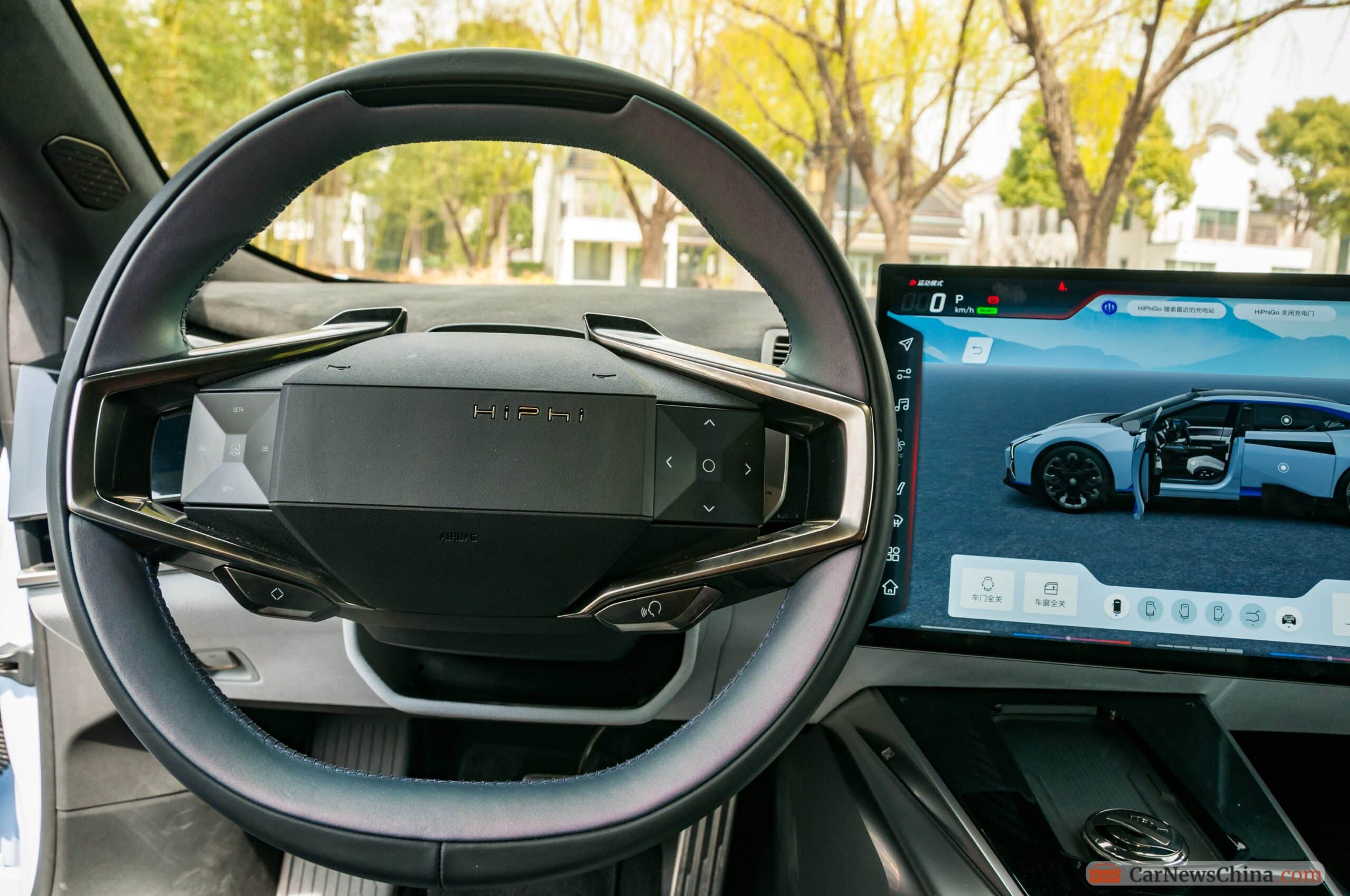
While there is no dedicated instrument screen the car gets a head up display which means the driver won’t need to look at the central screen much.
For the most part, the materials are luxurious enough, there’s leather, microfiber and even a crystal drive selector. However, the dashboard top is two layered with microfiber on the top giving way to hard plastic on the second layer edges.
The center console has a wireless phone charger and a small storage space under the floating console. There’s also a drink holder and a small cubby hole containing two USB type C chargers. Both driver and passenger get seats with heating, ventilation and massage functions.
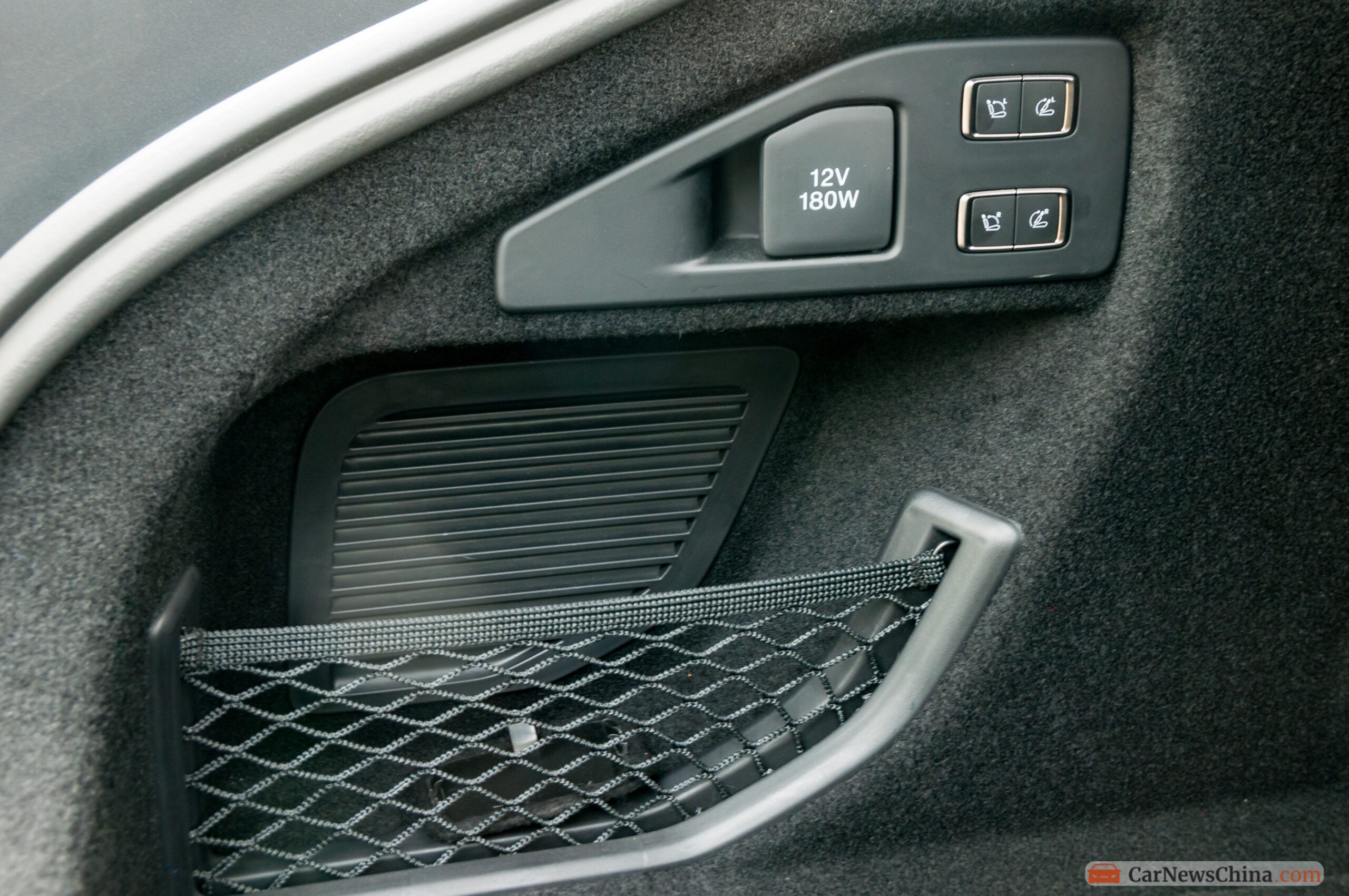
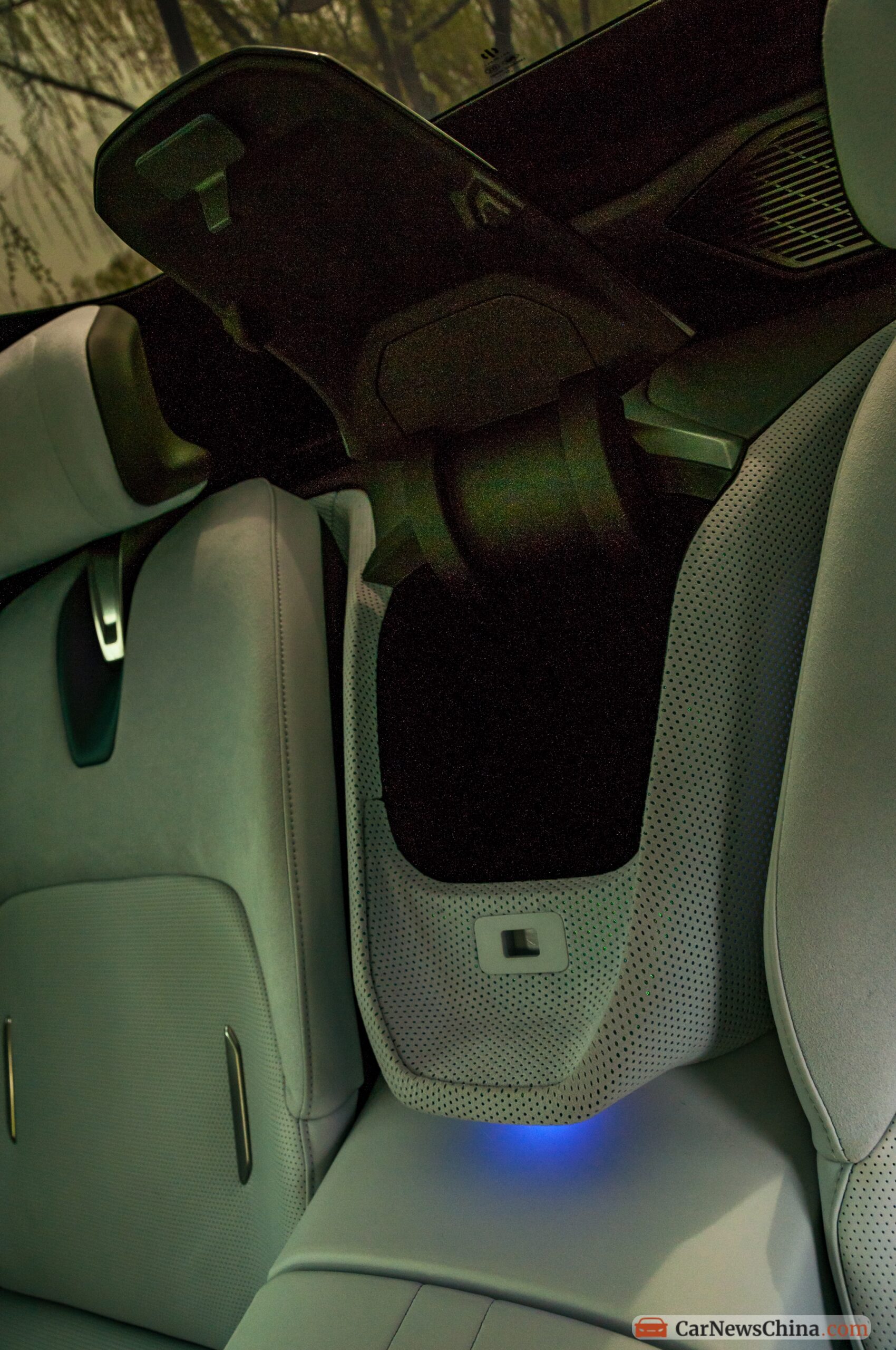
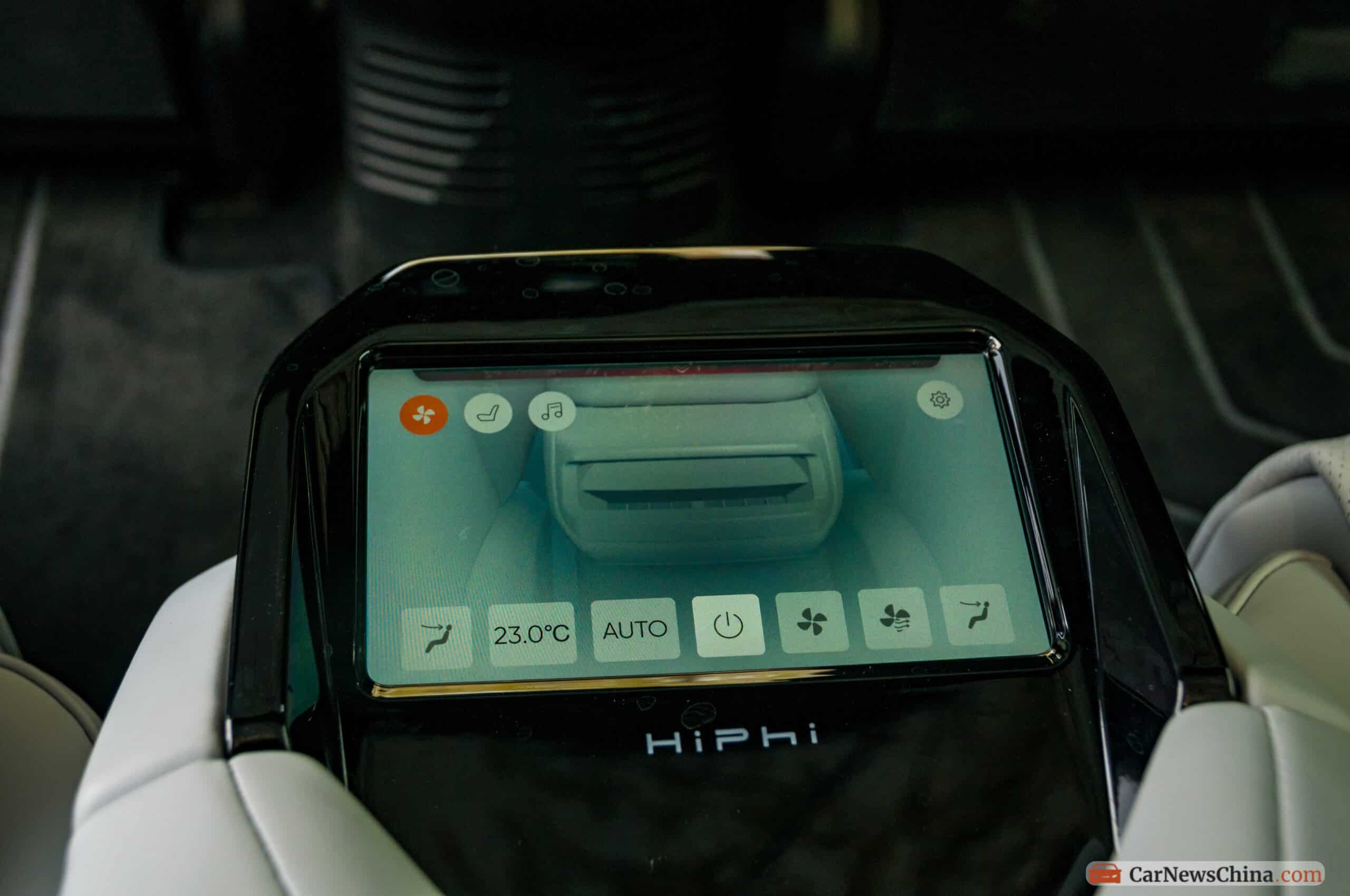
Our test car was the four-seater which gets a fixed center console between the two rear seats. In addition to the heating and electric rake adjustment on the five seater the four seater adds ventilation and electric cushion adjustment. These functions are all controlled by a 6-inch screen on the center console which can also control the entertainment system. Behind it is a small storage compartment containing two USB Type C outlets and there is another storage compartment at headrest level.
HiPhi says the panoramic roof blocks 99.9% of UV radiation meaning two hours in the car is equivalent to seven seconds outside. The heat insulation rate is 85% helping cut down on cooling requirements. In the four seater I had about three fingers from my head to the top of the roof – I’m 1.75m. However, I tried sitting in the middle seat of the five seater and I had to stoop my head forward due to the middle seat not having the well that the outer seats have. Legroom is reasonable. Trunk space comes in at 316 liters.
Performance and Driving Feel
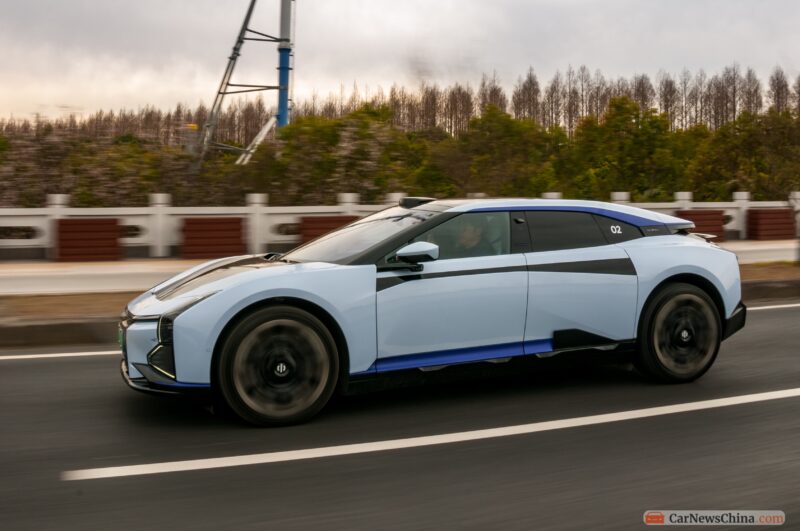
Perhaps we shouldn’t have been so surprised by the drive of the HiPhi Z, after all it is meant to be an electric GT, but it really is good. Acceleration wise it is just 0.1 seconds slower than a Taycan GTS at 3.8 seconds for 0-100km/h (0-62mph). However the real story is how it grips, the car feels really planted on the road and the steering is very precise. Our car did though have the optional (RMB20,000) flexible armor wheel pack which includes performance tires – the disadvantage is that range drops to 655km from the standard 705km (CLTC).
There is both four wheel drive and four wheel steering which obviously helps with the handling. With the four wheel steering the turning radius is just 5.7 meters and the car certainly feels maneuverable despite having a wheelbase of 3150mm. One interesting feature of HiPhi models is that you can signal you’re doing a U-turn by doing two quick pull downs on the indicator stalk.


In Eco and Comfort modes, the car cuts power to the front motor when being driven under 120km/h although the car still feels no slouch under such conditions. Sport mode on the other hand sees it continuously in four wheel drive. The Z has probably the best drive mode selector we’ve ever seen – paddle shifts! And if you pull them simultaneously you switch to the braking regeneration setup. I found low to be barely noticeable and as I favor high braking regeneration I drove the Z mainly with this. There are also gentle and medium options in between the two extremes. Under high, the braking effect from the regeneration doesn’t seem as high as in say a Nio, also unlike a Tesla true one pedal driving is not possible with the car coming to a coast rather than a halt.
Sum up
A lot of thought has gone into the HiPhi Z and how to make it user friendly. With its customization to Chinese consumers, it may well wrestle sales away from the Porsche Taycan, which is one of the better selling premium EVs in China. Can it repeat the success of the HiPhi X? Perhaps not, as this style of the car is not as appealing as a large spacious car like the X. That said HiPhi is going to Europe later this year with the Z likely to be the second model to go on sale and there this car might find a more eager market than in China.
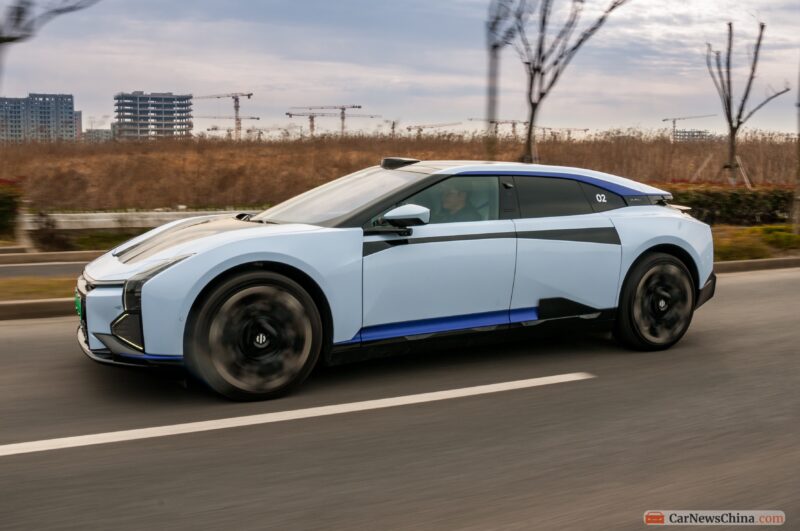
The Z adds Lidar but currently, this is only used for building up a picture of what is around the car. In a few months the self-driving capabilities utilizing this should come on tap via an OTA. It will certainly be interesting to see what the car can do once they are available.
Verdict
| Power & Drive feeling | 10 |
| Passenger space | 8 |
| Tech & UX | 10 |
| Price quality ratio | 9 |
| The best thing | How well it drives |
| The worst thing | Materials need to be better in places |
Overall: The HiPhi Z is a powerful follow up to the brand’s debut X. Less gimmicky it seems to be a really driver focused car, as a true GT should be! Of the two models currently available the four-seater is probably the better pick as the middle seat of the five-seater is not really that usable. True judgement though needs to wait until the driving aids fully come online in a few months’ time.
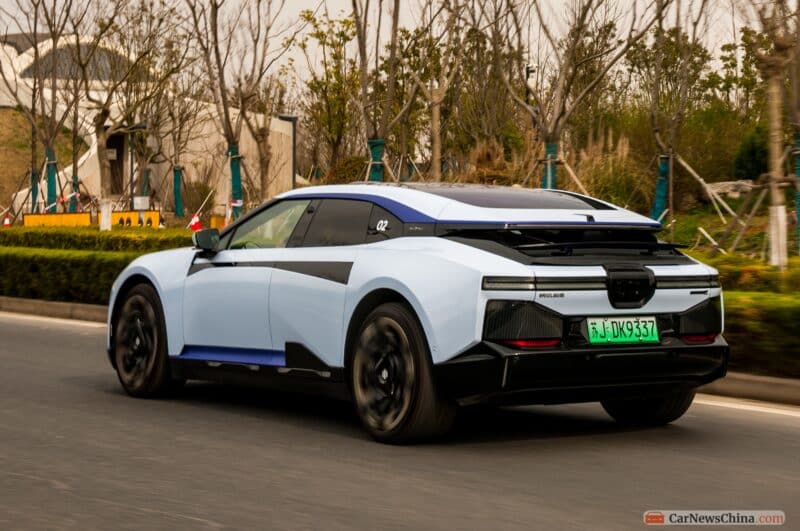
Q&A
Edit: We updated the article with answers to some of the readers’ questions
Have you already interacted with the HiPhi X, by any chance? I’m particularly interested in how they’re evolving from model to model as a brand.
The HiPhi X and I go back a long way. I was at the unveiling of the HiPhi One prototype and got to interview the original Chief Design Officer and Founding Partner, James Shyr about the car. Then I did a video about the unveiling of the production HiPhi X at the 2020 Beijing Auto Show and finally a test drive in the spring of 2021. Also, I got to use a HiPhi X as the chase car for the photography with the Z test drive. So yes, I’m pretty familiar with the HiPhi X!
At first glance I don’t think visually there is much resemblance between the two models. However, if you look in more detail, there are areas that look quite similar, for example, the slope of the bonnet, the B-pillar area, and the windows on the rear passenger doors. There is also a shark fin-like detail on the side of each model but in each case in a different position and with it the X facing up and the Z down.
I think it is a similar story with the interior, but this time it is more down to functions and features. For example, the ability to signal a U-turn and be able to project messages with the lights. Probably the real continuity is with the focus on the user experience rather than a physical element, and I think, in many ways, that is what the brand stands for.
How well is it actually built? Curious if it feels half-baked or surprisingly refined.
It is difficult to say, generally, in China, brands give the media pre-production cars to test. The problem with this is that often certain features don’t work and you are also left wondering how indicative elements are of production model quality. For example late last year I drove a Radar RD6 pickup which actually didn’t meet the published specs of any model, with elements from two different models!
So with the Lidar not fully operational, it’s not possible to test the driving aids. Also, the Z on the front door, while frameless has a window that is split into an opening and a fixed portion. These are met with a kind of rubber seal which on my test car seemed flimsy and looked like it would need replacing within a year. How representative that is of production models is difficult to say and is also more about the choice of supplier rather than build quality. Plus as mentioned in the article, there is an area of hard plastics on the second layer of the dashboard which really should have been designed out.
I’d be curious about acceleration as the battery is reduced (100% vs. 80% vs. 60%), and if there are any limitations to how long you can use full power, i.e., Mach-e 5 second limit. We’ve seen good power numbers from manufacturers, but in reality, there are software or cooling limitations that mean you can only use the power in very limited circumstances.
Good question. I can’t say I really fully tested this. However, what I know according to HiPhi is that the Z has the best continuous output capability in its class, and the continuous peak torque output can last up to 30 seconds. Furthermore, the braking distance from 100km/h to a standstill is 34.8m, and HiPhi says this can be done 10 consecutive times without heat decay.
How do the auto doors work in a tight parking space? Does it open just enough to avoid slamming into another car?
First off the car is very wide so it would be best to avoid a tight parking space! Doors if they sense an obstruction will not fully open. I think I’m right in saying the app allows you to take the car in and out of a parking space without a driver.
That YYP channel I mentioned earlier just dropped a track test of the Z, and he was pretty complimentary of its on-track chops, despite the size and weight of the car.
Apparently in sports mode, it normally does a 70/30 rear to front split of power output, until you floor it, at which point it is more 50/50.
And the rear steering is up to 13 degrees, which is quite high I think. On top of that, he said in sports mode, the rear steering remains opposite of front until 80 km/h (versus around 30 km/h in normal mode), which means it is supposed to aid in low-speed cornering on the track.
They even gave him a special prototype with rear steering and ESP fully turned off, and he said he could get a drift going in the corners.
I’m not sure why Human Horizons is spending so much money to develop the trackability of a crazy looking 100k USD electric sedan, but apparently, it is quite sporty on the track.
I was originally offered a drive on the track in Beijing, but this didn’t happen for various reasons so I can’t really comment on how the car performs on the track. Like you, I have heard that it does drive well and based on my experience driving the HiPhi Z on the road I can fully believe this.
Weight distribution is almost 50:50, and the maximum rear wheel rotation angle is a maximum of ±6.6°. As for the power, I have not heard that. Certainly in Eco and Comfort, the Z largely operates as an RWD car whereas in Sport the front motor is permanently on as well.
Based in Shanghai, Mark Andrews is one of the leading English language authorities in the Chinese auto industry. You can follow him on Twitter.



